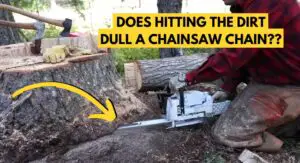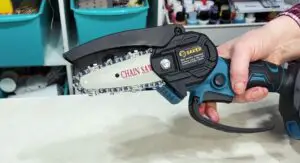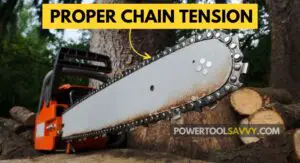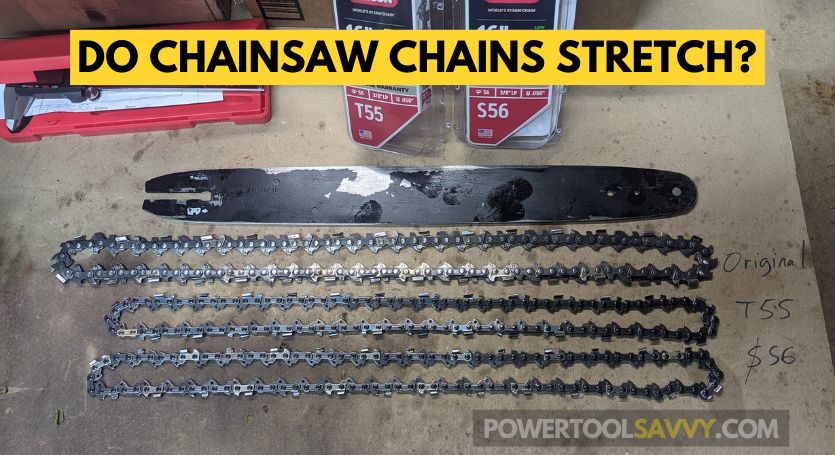
Yes, chainsaw chains do stretch over time. This is normal and happens mainly due to the friction and heat created when the chain is in motion. Also, when the links get worn out and loose, the chain can stretch even more.
Btw, I’m Samuel, and I have over 20 years of experience working with chainsaws 😎. And in this article, I’ll be talking about –
- What causes a chainsaw chain to stretch faster (and how to prevent it),
- How to tell if a chainsaw chain is stretched,
- How much does a chainsaw chain stretch,
- Can you shorten a stretched chainsaw chain, and many many more!
So, Are you READY??
Let’s get started…
Table of Contents
ToggleWhy Do Chainsaw Chains Stretch? (Don't SKIP!)
As already mentioned, chainsaw chains get stretched over time due to the heat generated by friction.
Sounds confusing?? Let me explain:
Chainsaw chains are typically made from metal (“stainless steel” particularly). They feature a series of interconnected links that enable them to move in a continuous loop around the guide bar.
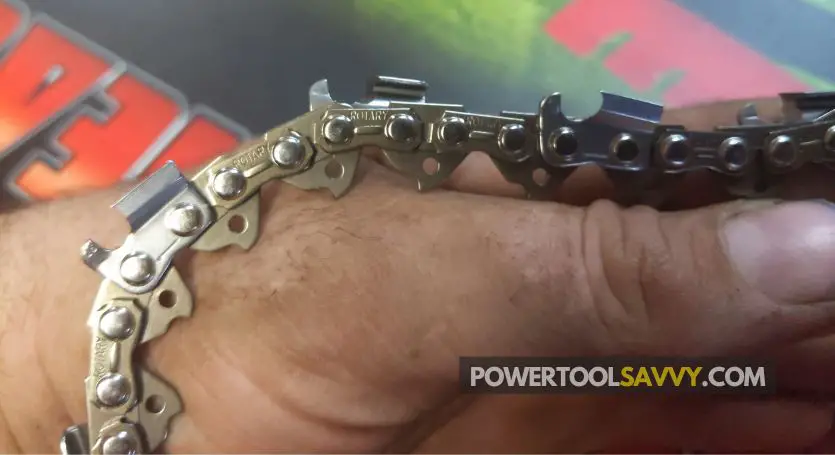
When a chainsaw is in operation, the teeth of the chain come into contact with wood, creating some serious friction that makes the chain heat up. 🔥
As the temperature goes up, it makes the links expand, and that’s what causes the chain to stretch!
And GUESS what!!
This stretching can result in:
- Slack chain tension,
- Reduced cutting efficiency,
- A higher risk of kickback,
- More frequent instances of the chain coming off, and the list continues.
What Causes a Chainsaw Chain to Stretch Faster?
Common reasons for a chainsaw chain to stretch prematurely include a worn-out chain sprocket, a faulty chain lubrication system, a damaged guide bar, dull teeth, and improper chain tensioning.
Also, cutting hardwood, and hitting dirt or other abrasive materials (rocks, metal, concrete, etc.) can result in faster chain stretching.
Here are 8 main reasons why chainsaw chains tend to stretch more quickly:
1. Worn-Out Chain Sprocket
Here’s what you need to know: 👇
The Chain Sprocket (also referred to as the “Drive Sprocket“) is linked to your saw’s engine and plays an important role in driving the chain around the guide bar.
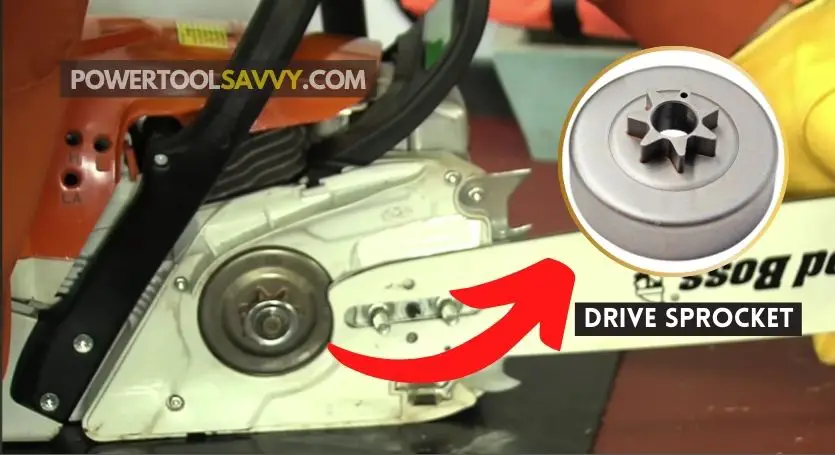
However, as the chain sprocket wears out, it forms deep grooves in the teeth (see the image below 👇), which diminishes its ability to maintain the same level of grip as before!
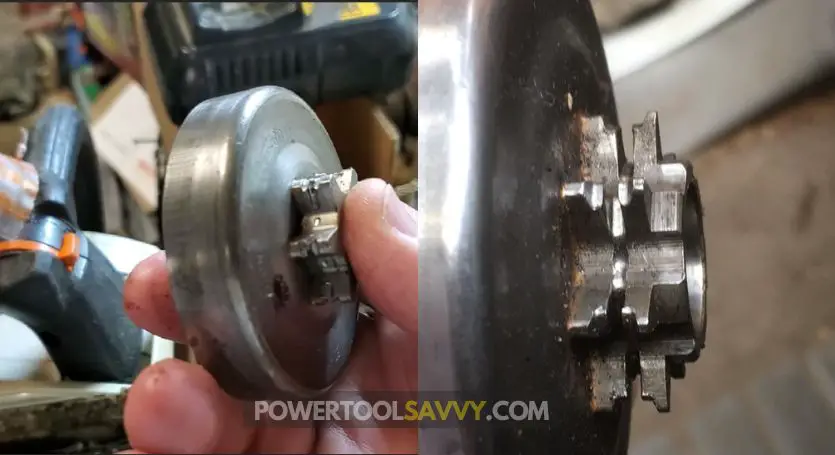
And what happens is, the drive links of your chain can’t stay firmly in place. Instead, they keep slipping, and that leads to both heat buildup and chain stretching.
Oregon says, “You should replace drive sprocket systems after every two chains, or sooner. It’s important not to run a new chain on a badly worn drive sprocket.” (Source)
I’ve written an entire article on this topic. Learn More: When to Replace the Chain Sprocket?
2. Cutting Hardwood
Cutting hardwood can also cause your chainsaw chain to stretch quickly!
“What do you mean by that?“
You see, hardwoods like oak, maple, and cherry are denser than softwoods like pine, cedar, and spruce.
Also, the wood fibers of hardwood are more tightly packed together, which requires more force to cut through.

This means your chain has to roll up its sleeves and work extra hard on hardwood.
And, as it sweats through this extra effort, it builds up a bunch of friction and heat, causing the rivets to start expanding!
3. Faulty Chain Lubrication System
The main gig of the oiling system is making sure the chain and the guide bar stay slick, well-lubricated, and chill while getting the job done.
But here’s the hitch!
If that lubrication system decides to call it quits, it won’t be spreading enough oil to keep things cool.
That means serious friction (and heat) will kick in between the bar rails and the chain, and that’s a recipe for the chain to stretch out real quick over time!
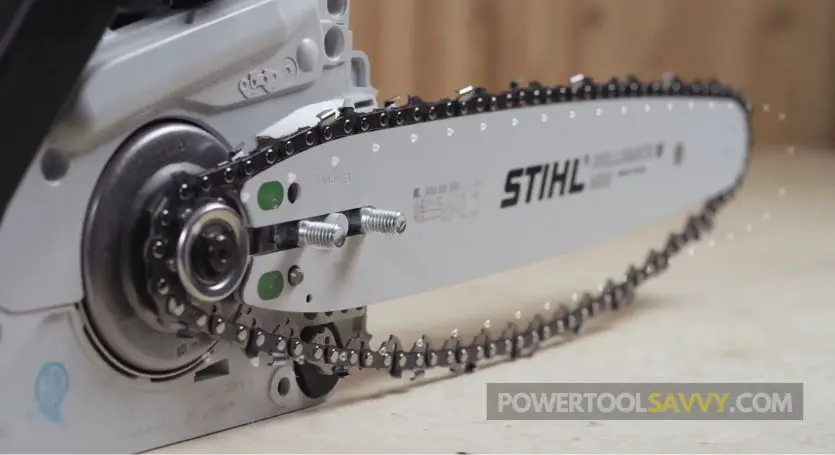
But how can you tell if your chainsaw’s oiling game is off?
Well, that’s quite EASY!
- Turn ON your chainsaw and let it run for 1-2 minutes.
- Point the tip of your bar at something light-colored like a wall, cardboard, or a piece of paper.
- Now rev up your saw.
If you don’t spot a sleek, shiny line of oil being shot out from the bar tip (check out the image below 👇), well, then you’ve got yourself a lubing system that’s on the fritz.
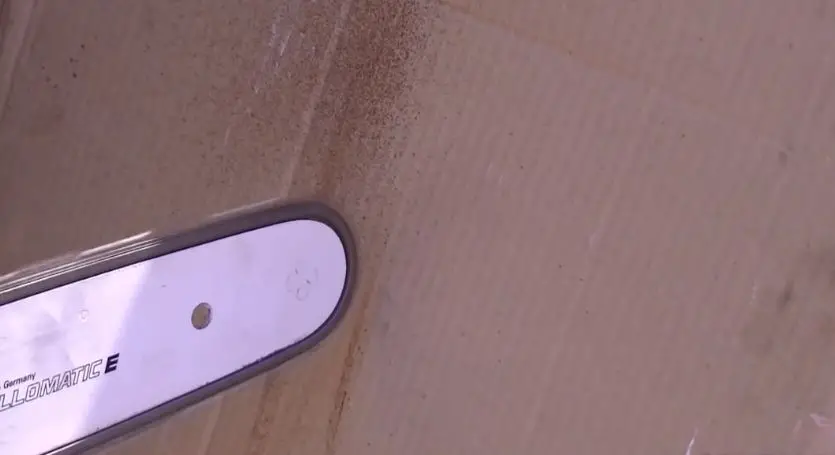
Anyway, I’ve written an entire article on this topic. If you want to learn more, go and check that out: how to fix a chainsaw that’s not oiling?
4. Dirt in the Bar Groove
The bar groove is the track where the chain runs. It plays a significant role in distributing oil to the chain and bar evenly.
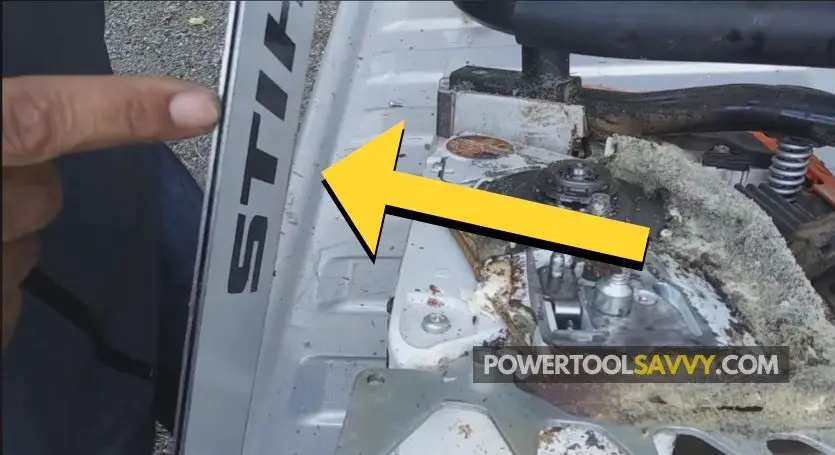
But as you use your chainsaw regularly, all sorts of gunk like dirt, sawdust, and debris decide to camp out in that groove.
And guess what?
They’re like vacuum cleaners, sucking up all the lube, making your chain move like it’s dragging its feet, and cranking up the friction meter.
The end result? Your chain stretches more than it should.
This is why I make it a habit to clean the bar groove once every 30 days – it helps avoid any accumulation of dirt and ensures that my chains remain in good shape!
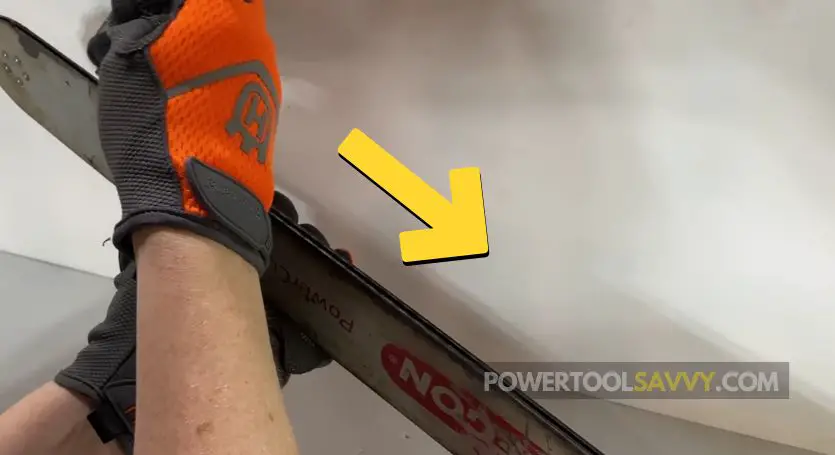
To get the job done, I use a specialized bar rail cleaning tool, which you can easily find on Amazon or at any power tool store.
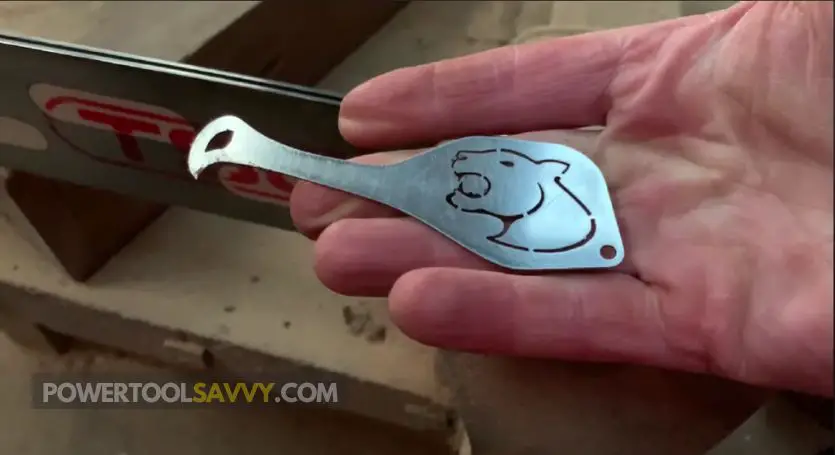
5. Wrong Chain Tension
Incorrect chain tension is another factor that can lead to premature chain stretching.
“What does that mean?“
If you’ve cranked that chain too tight, it’ll be too rigid around the bar, leading to additional friction. And that extra friction will have the chain stretching out faster than your expectation.
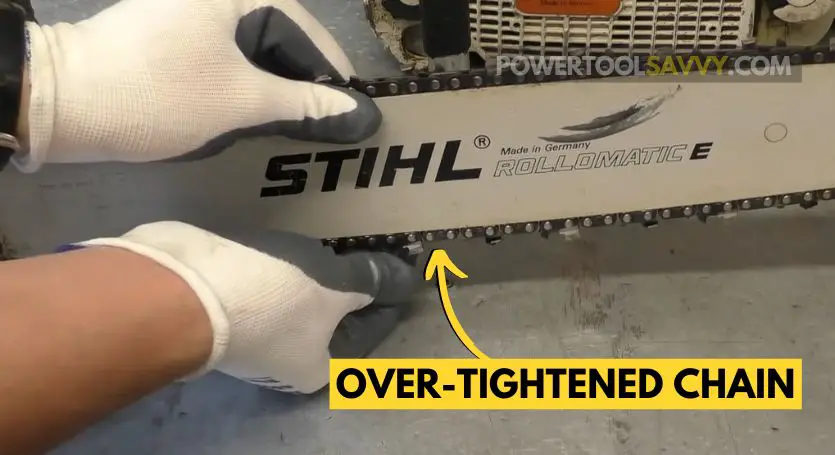
Not only that!
If your chain is extremely loose, it’ll flail around the chainsaw bar and produce heat, which can also lead to usual stretching.
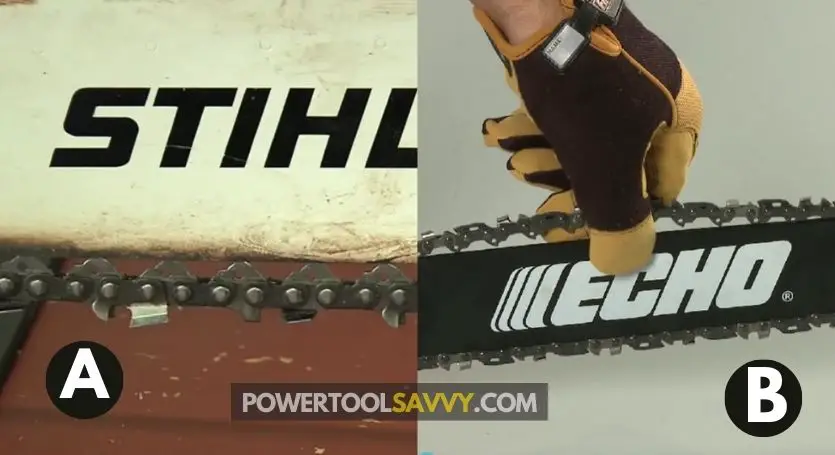
So, what’s the takeaway from all this?
You need to make sure that your chain is always tightened to the proper tension. This simple step will keep your chain from stretching unnecessarily!
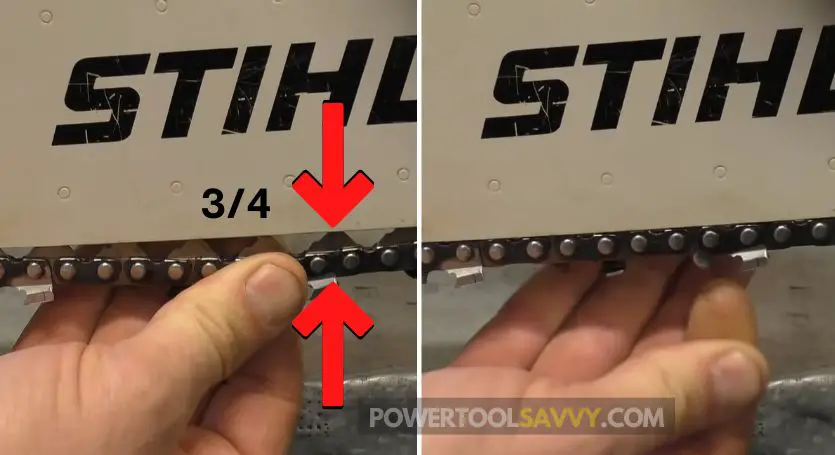
Read this article, where I’ve explained how tight should a chainsaw chain be in great detail!
6. Dull or Improperly Sharpened Chain
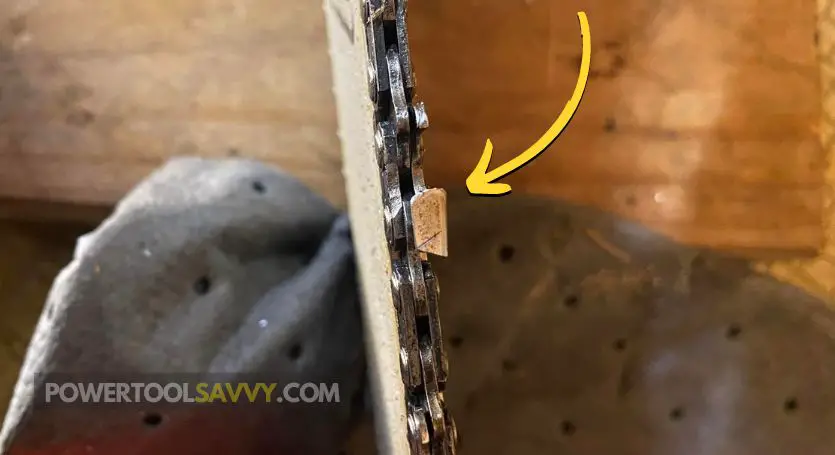
When chainsaw chains get dull, they just keep grinding away.
This excessive grinding leads to a ton of friction and heat, which can ultimately result in chain stretching or even snapping.
So, It’s important to keep your chain sharp at all times! (Check out this article where I’ve detailed the easiest ways to identify a dull chainsaw chain.)
The SAME goes for an improperly sharpened chain.
When I say “improperly,” I’m talking about – 👇
- Not sharpening the teeth at the CORRECT angle,
- Neglecting to file down the depth gauges to the right height,
- Failing to align the cutters properly, or
- Using the WRONG size file.
Here’s how an “improperly sharpened” chain looks:
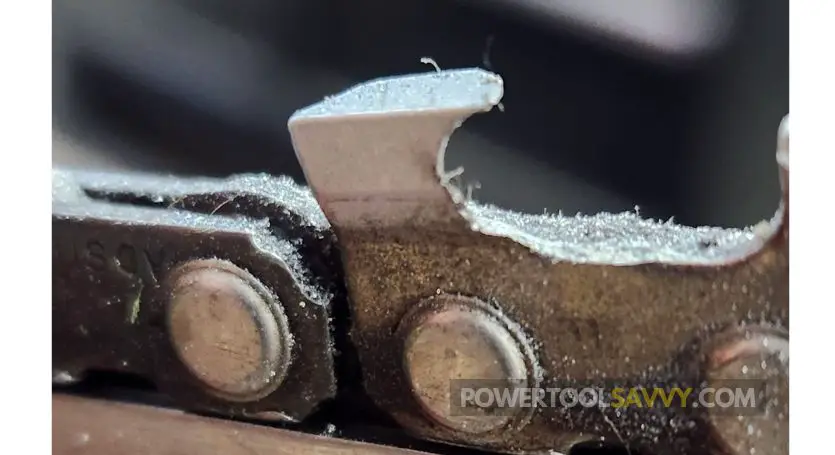
7. Hitting Dirt or Other Abrasive Materials
Dirt and Chainsaw don’t MIX well together!
Dirt is abrasive. It contains tiny bits of rocks, sand, and other hard particles that can wear down the sharp edges of a chainsaw chain. (Learn More: Does Dirt Dull a Chain?)
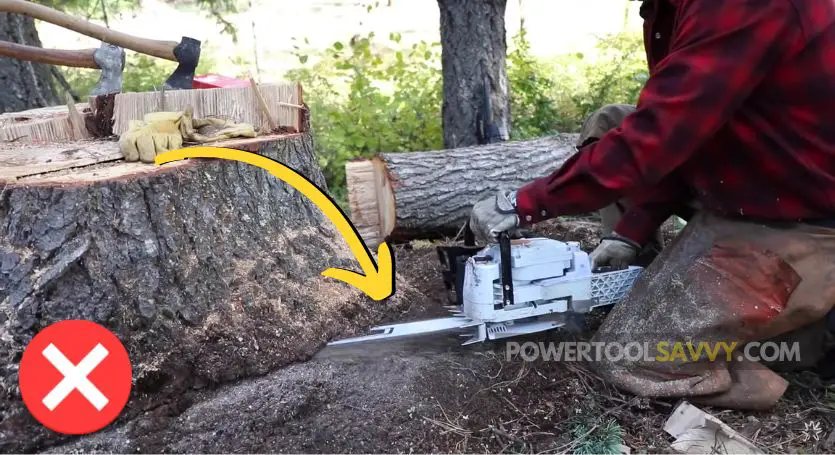
That’s NOT all!
When your chainsaw hits the dirt, those hard particles work like sandpaper, creating extreme friction.
As a result, your chain heats up significantly and stretches more rapidly than it should.
And, that’s why it’s best to steer clear of cutting into dirt or hitting the ground with your saw!
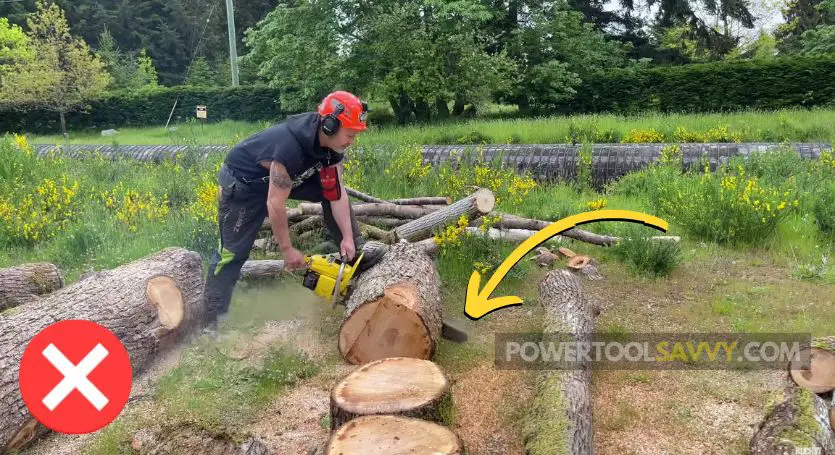
Also, make sure you don’t hit any other abrasive materials like metal, nails, concrete, or spikes with your chainsaw.
Related Articles: 👇
8. New Chainsaw Chains Stretch Quickly
It’s NO secret!
Fresh chains have this “break-in” phase where the links in the chain need to get comfy and stretch out a bit.
So, as you work your chainsaw, these links 🔗 start to loosen up, making the chain grow.
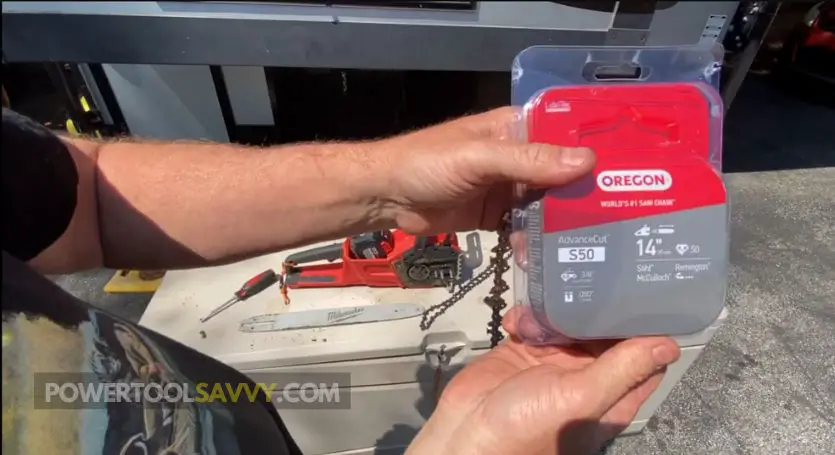
That’s why, after putting on a new chain, you should keep an EYE on the tension!
If it gets all floppy, just hit pause, tighten it up, and get back to the cutting action! (Read this article where I’ve shown how to tighten a chainsaw chain!)
Can You Stop a Chainsaw Chain from Stretching? (Don't SKIP!)
Unfortunately, there’s no way to prevent a chainsaw chain from stretching. When you put a chainsaw to work for the long haul, that chain will eventually stretch because of all the heat and rubbing.
It’s just part of the deal, and it happens to all chainsaw chains out there!
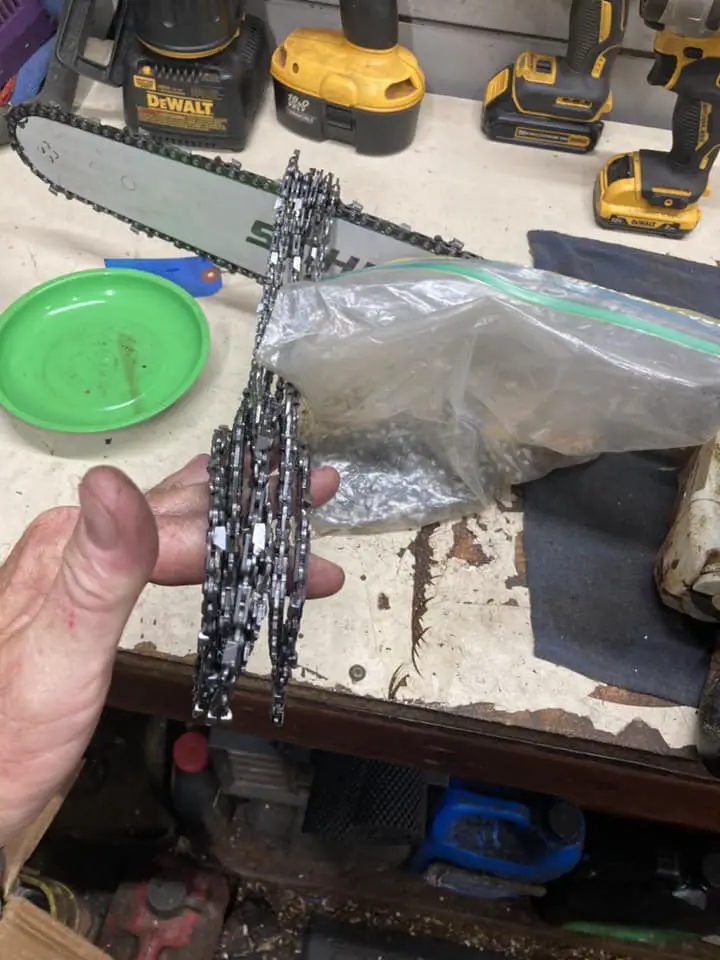
But guess what??
You can cut down on that stretching action by sticking to some easy-breezy pointers.
Here are 8 of them: 👇
- Keep your chainsaw chain sharp and lubricated,
- Make sure the chain tension is on point,
- Avoid using the chainsaw in dusty and dirty conditions,
- Opt for a semi-chisel chain for hardwood,
- Keep your guide bar clean,
- Swap out your chain sprocket if it’s seen better days,
- Don’t go overboard with super aggressive cuts, and
- Don’t push your saw too hard into the wood.
Following these simple tips, you can SLOW DOWN the stretching process and extend the lifespan of your chain.
Can a Stretched Chainsaw Chain be Shortened?
Yes, it’s possible to shorten a chainsaw chain. Tools like chainsaw chain breakers and spinners come in handy for this task, letting you snip off those extra links.
I’ve written an entire on this topic where I explain the process of shortening a chainsaw chain in GREAT detail!
Also, here’s a video tutorial that explains it in a much more detailed way: 👇
However, it’s NOT as easy as it looks!
One MISTAKE and you might end up ruining your chain!
On top of it, shortening the chain isn’t the most efficient method to fix a stretched-out chain. It’s often a better idea to simply replace it.
How Can I Tell If My Chainsaw Chain has Stretched?
Well, no need to stress!
Here are 3 signs that your chainsaw chain has done some stretching: 👇
- Unusual noises coming from the drive sprocket – A stretched chain can make the drive sprocket produce a loud, rattling sound.
- Your chain won’t tighten anymore – It’s a bit peculiar, but if your chain has stretched a lot, you might reach a point where you can’t tighten it any further. (Learn More: Why Won’t My Chain Chain Tighten?)
- Your chain keeps coming loose – If your chain keeps getting loose more often than not, even when you’ve tightened it correctly, that’s a clear sign of stretching.
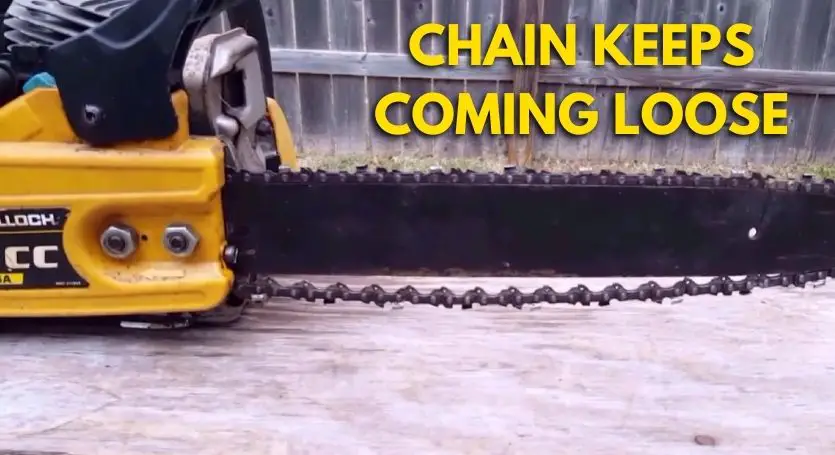
That’s not all!
There’s another method that I often use to check if my chain has stretched – comparing it to a NEW one.
Yup, you heard me! 🐸
If you’ve got a NEW chain that has the same pitch, gauge, and drive link count, simply lay it out next to your own and see if there’s a difference in length.
If the used one looks noticeably longer, that’s a SURE sign that it’s stretched!
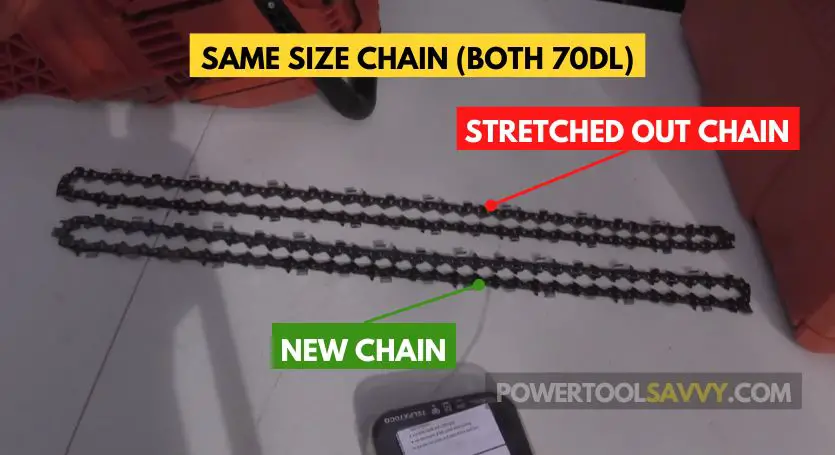
How Much Does a Chainsaw Chain Stretch?
A chainsaw chain can naturally stretch by about 1-2% from its original length during regular use. But if you really put it through the wringer, it could stretch up to 3%.
But here’s the deal – don’t shrug it off!
I make it a point to swap out my chain once it’s stretched past that 2% threshold. (And I strongly recommend you do the same!)
Trust me, it’ll save you a ton of time ⏲️ and elbow grease 💪. You won’t have to keep checking and adjusting the chain tension every few minutes.
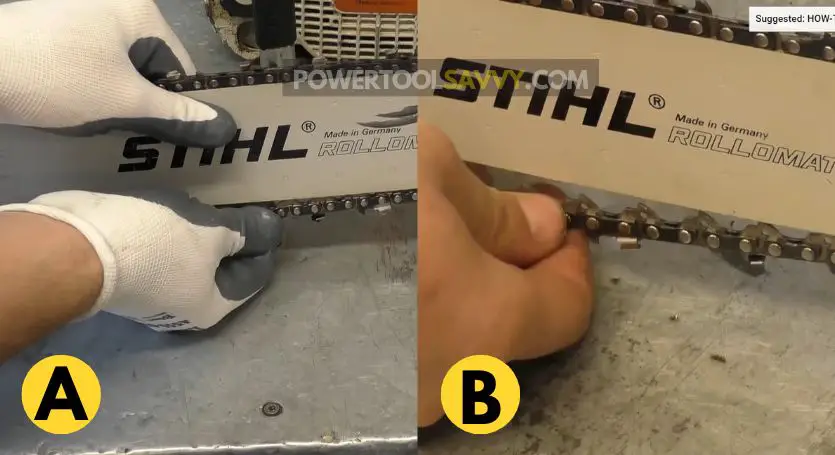
On top of it, using a stretched-out chain can put a lot of strain on the motor and sprocket, leading to reduced cutting performance.
And most importantly –
When choosing a chain for your saw, make sure you get the RIGHT one. Because the “one-size-fits-all” theory doesn’t work here! (Read More: Are Chainsaw Chains Universal?)
GoodBye Words!
So, YES, chainsaw chains do stretch over time. This is usually due to the metal expanding and contracting when exposed to extreme temperatures or moisture. Also, when the links get worn, the chain will stretch.
If you’ve got any questions, don’t hesitate to reach out.
Happy sawing!

